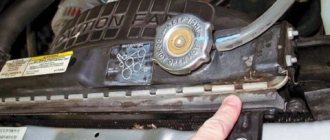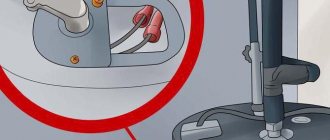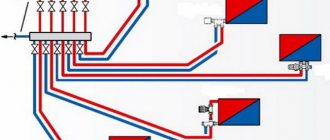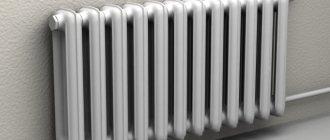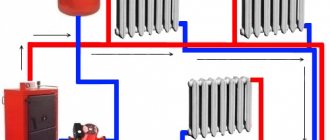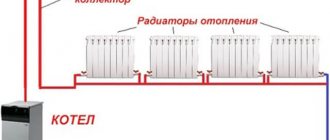Purpose of the radiator
Contrary to popular belief, a car cooling radiator performs several functions at once. His tasks include:
- Heat removal from product elements and its transfer to the atmosphere.
- Providing the possibility of adding and removing coolant (antifreeze, water, antifreeze) using special holes at the bottom and top.
- Creation of optimal pressure inside the system, thanks to the presence of a relief valve.
The main function of the radiator is to exchange heat and reduce the coolant temperature to a safe level.
Depending on the situation, cooling occurs by blowing with counter air or a fan, which starts when a certain temperature is reached. Depending on the make/model of the vehicle, the fan may be mechanical, electric, or hydraulic. The second option is considered the most popular.
General concepts, purpose
In the cooling system, the engine radiator serves as the main heat exchanger: heated antifreeze passes through its tubes, being cooled by an air flow. For this purpose, the radiator is placed in the front part of the body, immediately behind the radiator grille, where the oncoming air flow can be used when driving. And for cases when the car is moving through traffic jams (slowly), a fan is installed behind the radiator, providing forced airflow. Thus, the antifreeze, passing through the “honeycombs,” is cooled to a temperature of 80-90 ° C, ensuring optimal engine operation.
Engine cooling system diagram
In the very first cars, a cooling system with natural convection was used: heated antifreeze (at that time plain water was used) passed along its path due to the temperature difference: the hotter liquid has a lower density, and the colder liquid has a higher density, and due to this difference, the antifreeze flowed freely through system. Now, with the development of speeds and loads on the motor, the need for cooling also increases, so antifreeze circulates using a pump that ensures the speed of movement through the system. The engine cooling radiator has also changed: in addition to the tubes, fins (plates) have appeared on it for better heat transfer. But the principle itself remains the same: hot antifreeze enters the upper part of the radiator, passes to the bottom, cooling along the way, and again enters the cooling system.
How does the engine cooling system work?
When considering a radiator, it is important to know the features of the car's cooling system, which is designed to reduce engine temperature to a safe level. In addition, its functions include heating the air, cooling the exhaust gases, the flow in the turbocharged system, as well as the oil in the automatic transmission. Structurally, the cooling system can be liquid, air or mixed. The most popular is the first option. Structurally, it consists of the following elements:
- Radiator. The main unit through which coolant passes to reduce the temperature.
- Water pump. Guarantees the circulation of working coolant throughout the system. It can be belt, gear or other types.
- Thermostat. Necessary to regulate the process of antifreeze passing through the radiator. It can have three positions - closed, partially / fully open.
- Fan. Triggered to increase airflow efficiency. Most often necessary when the car is moving at low speed and the air flow is not enough for cooling.
- Temperature sensor. Controls the temperature regime and gives a command when it is necessary to start additional cooling.
- ECU. The main unit that receives signals and regulates the operation of the car’s engine cooling system.
Depending on the car, other components may also take part in the operation, for example, an engine cooling relay, a heater, a thermostat, a fan control unit, etc.
Important
All elements interact closely with each other. So, after starting the engine, the coolant circulates using a pump in a minimal circle - through the block and cylinder head without passing through the radiator.
This is done for faster heating. As soon as the temperature reaches 80-90 degrees Celsius, the sensor is triggered and sends a command to open the thermostat.
In this case, antifreeze is directed through the radiator to maintain normal temperatures. If the engine continues to heat up, a signal is sent to turn on the fan, providing additional airflow.
All radiators in a car - types, functions
Cleaning the radiator is an important procedure for preparing your vehicle for the summer season. Too high a temperature and frequent traffic jams lead to overheating of any equipment. As a result, the cooling system is forced to work under high load. Therefore, after 5-7 years of operation, it is necessary to remove dirt from the radiator honeycombs. To do this, motorists simply remove the main cooling element and wash it with running water. However, not everyone knows that a car has several radiators. They are responsible for different functions, but they all work together to cool certain elements in the vehicle structure. If you ignore cleaning them, it will be impossible to achieve normal operation of the car components. Let's look at where these radiators are hidden and how you can get to them.
A pump is responsible for pumping liquid through the system, which creates acceptable pressure and prevents stagnation of liquid
Cooling radiator . The main element in the engine cooling system is the radiator. It is installed in the front of the engine compartment and takes over the air flow to cool the working fluid. Antifreeze acts as a refrigerant in this system. This fluid circulates along the circuit of pipes and channels inside the motor. The liquid is pumped through the system by a pump, which creates acceptable pressure and prevents stagnation of the liquid.
If the radiator is not ventilated and the engine temperature rises above the limit, the fan is turned on. After only 5 years of operation, the front radiator becomes quite clogged with dirt, insects, leaves, chemical dust and other debris. Therefore, its airflow is naturally disrupted, and proper cooling of the antifreeze does not occur. As a result, the main radiator must be removed and washed separately. You cannot use a Karcher for this purpose, as a powerful jet can crush the radiator cells.
The main advantage of this radiator is that, due to its location, it almost never gets dirty
Stove . Another standard radiator is located in the stove. It is located in the car in order to warm up the interior, and in some cases serves as an additional antifreeze cooler. If you activate the heater at full power, in traffic jams when the cooling system overheats, you can remove excess temperature from the engine. However, sitting inside the car will not be comfortable due to the too high temperature. The main advantage of this radiator is that, due to its location, it almost never gets dirty. But over time, it still fails due to leaks.
Air conditioner . There is another important radiator in the air conditioning system, which is necessary for the correct operation of the air conditioner. This device is called a condenser because refrigerant vapors condense in it. High-temperature freon, which is in a gas state, turns into a liquid state in this cooler. In this case, excess heat is released into the atmosphere. The liquid refrigerant goes directly to the evaporator, where, with a sharp decrease in pressure, it begins to expand and turns into steam. During this process, the surface of the evaporator and the air that enters the vehicle interior are cooled.
The cooling efficiency of an air conditioner depends on the condenser's ability to transfer heat, so it should not become clogged. The condenser can be cleaned without removing it from the car. To do this, you must first disassemble the front part, remove the bumper and other elements that interfere with access.
During operation in the torque converter, the oil increases the temperature and requires additional cooling
Automatic transmission radiator . Another radiator is located in the automatic transmission to cool the internal oil. During operation of the transmission, the oil is pumped through the filter and passes through the hydraulic distributor, which redirects it to the automatic transmission mechanism and torque converter. During operation in the torque converter, the oil rises in temperature and requires additional cooling. Therefore, the liquid is sent through a separate line to an external cooler. On some car models it is combined with the main radiator. But there are models in which it stands separately in the lower part of the engine compartment.
Power steering radiator . The power steering is another component that needs cooling. Inside, the working oil gets very hot during active maneuvering or off-road driving and stops working effectively. As a result, handling problems may arise, which is why a small power steering radiator is located in the engine compartment. It is located in the lower part of the nose behind the bumper. Its design does not include small cells, so it rarely gets dirty. However, its condition should be checked periodically to monitor tightness and detect possible leaks in a timely manner.
It is needed in the system in order to lower the temperature of the compressed air
Turbine intercooler . Turbocharged power units use an additional radiator called an intercooler. It is needed in the system in order to lower the temperature of the compressed air. The air is heated by the turbine and passes through the radiator under pressure, at the same time it is further compacted and creates the mixture consistency necessary for engine operation. Denser air allows the turbine engine to develop more power. The intercooler is placed in the front of the car behind the bumper or radiator grill so as not to get in the way of the forced air.
Cooler under the bottom . Some diesel cars have a separate radiator in the exhaust system. This is the exhaust gas recirculation cooler. It is necessary in the design in order to lower the temperature of the gases.
Bottom line . Many people believe that a vehicle only has one cooling radiator. However, there can be more than 5 of them in a car, and each of them needs to be cleaned.
Types of radiators
Structurally, the devices under consideration differ in several criteria: assembly method, case material and additional elements. Taking into account the features, the price of a car radiator also differs. By design they are:
- Tubular-plate. They consist of tubes, inside of which so-called turbulators are mounted. This is done to lengthen the coolant path through the radiator and, accordingly, improve cooling. Such devices have greater rigidity and a minimal percentage of defects.
- Tubular-tape (soldered). Unlike the previous version, all elements are connected by soldering, which complicates the maintenance process. Such radiators have higher heat output and lower price.
There are two options based on the number of moves:
- One-way. Fluid flows in one direction.
- Two-way. The coolant path is more complex. First, the antifreeze passes through part of the tubes in one direction, and then in the second compartment it changes direction.
According to the material:
- Copper. More expensive. They are characterized by increased strength and better heat transfer. Easily repaired by soldering.
- Brass. They are rarely found in their pure form. Copper-brass structures are most often used.
- Aluminum car radiators. Appeared against the backdrop of rising copper prices. In production, modern welding methods are used, providing increased reliability and strength. Despite the worse heat transfer, such products cope with this task.
Today, all car engine radiators are made of aluminum. They have a lower price, but require a special approach to repair. For restoration, conventional soldering is not enough, because it usually has low efficiency. Argon welding is most often used.
Coolants
A coolant (liquid) moves inside the system, which, when passing through the radiator, is cooled and returned to the engine. Conventionally, all coolants are divided into several types:
- Distilled water. The most economical option that does not require the purchase of additional funds. It is used in the warm season, when there is no risk of the system freezing.
- Antifreeze is the old name for coolant used in the USSR. Previously, such compositions were poured into Zhiguli, but today they are almost never used.
- Antifreezes are modern coolants that contain special additives. They differ in terms of service life, corrosion protection features, the presence of additives and other features.
Conventionally, antifreezes are ethylene glycol, carboxyl, hybrid, lobrid and propylene glycol. They differ in characteristics, composition, set of additives and characteristics. For example, inorganic corrosion inhibitors are used in ethylene glycol compositions, and organic ones are used in carboxyl compositions. Hybrid and lobrid ones contain organic and inorganic components. As for propylene glycol coolants, they use safer propylene glycol.
The task of modern antifreezes is to remove heat, protect against corrosion and clean the car radiator from contaminants accumulated inside.
At the same time, the anti-corrosion function is considered the most important, and the effectiveness of this option directly affects the price. When choosing a coolant, you need to focus on the manufacturer’s recommendations in relation to the car brand.
Damage, malfunctions and repairs
The radiator cannot be called the most reliable component of a car. During operation, it is affected by many negative factors, including mechanical ones. The most common damages include:
- Contamination of pipes and central part. In this case, flushing may be required.
- Fan damage.
- The accumulation of dirt and leaves on the outside of the product, which reduces heat transfer.
- Damage to the pipes or the radiator itself with subsequent leakage of coolant from the system.
- Corrosion of internal elements.
If any of the problems discussed above occur, there is a high risk of engine overheating, so the car’s radiator needs to be repaired. A sign of a breakdown may be the appearance of an antifreeze leak or rapid overheating of the engine during moderate operation.
The most difficult case is when the engine “boils” and steam starts coming out from under the hood. In this case, you need to stop and wait for the system to cool down. Only after this can you begin to troubleshoot the problem. If the problem occurs on the road, do the following:
- Check the tightness of the connections of all tubes.
- Make sure the cooling fan operates.
- Check relay wiring and temperature sensor.
- Add the required amount of coolant. Be careful as there is a high risk of hot liquid splashing.
It is better to entrust repairs to professionals. If it is not possible to go to a service station, you can use epoxy resin or “cold welding”. You must first drain the coolant from the system and remove the device from the car for easier access. There are other repair methods:
- Welding. Used when there is minor damage. Suitable for copper or brass devices. Requires a gas torch and degreaser. When performing argon welding on an aluminum “cooler”, aluminum wire is needed.
- Replacement. In a situation where the tube is damaged along its entire length, it will not be possible to solder the car radiator or weld the hole. The only way to solve the problem is to replace the old tube with a new one.
When deciding on the need and method of repair, it is necessary to assess the damage. In the most severe cases, the entire radiator may need to be replaced.
Prevention and care
To extend the life of the product, proper care and regular maintenance are required. It is important to understand that the radiator absorbs all the dirt and dust and therefore needs to be flushed periodically. If nothing is done, the device quickly becomes clogged and stops performing its functions.
The main means of prevention is periodic flushing and cleaning of the car’s cooling system. You can do this yourself or entrust the work to a specialist.
| Stages of flushing a car's cooling system |
| 1. Allow the engine to cool, secure the hood and put on special gloves that do not allow water to pass through. |
| 2. Drain the antifreeze from the cooling system and fill it with distilled water |
| 3. Start the engine and leave it for 20-25 minutes |
| 4. Drain the liquid and repeat this procedure several times to completely clean the system. It is necessary to act until clean water begins to come out of the system. |
| 5. At one stage, add cleaning agent to the water to better clean the system. You can find special formulations on sale, for example, Winns Radiator Flush |
During operation, we must not forget that the radiator can become clogged from the outside. The pollutants are leaves, dirt, dust, etc. To solve the problem, you need to dismantle the product and blow it with air pressure or rinse it with a stream of water under high pressure. The main thing is not to overuse the pressure to avoid damaging the device’s cells.
After this, it is necessary to fill the system with high-quality antifreeze with a set of necessary anti-corrosion additives. To eliminate air locks, open the cap on the radiator and start the engine. After some time, the air will come out on its own, and all that remains is to add coolant to the system.
Design and principle of operation of an engine cooling radiator
The cooling system plays a very important role, since it is it that prevents overheating of the car engine, which is inevitable during operation. The most important element of the cooling system is the radiator, which ensures efficient cooling of the liquid.
A car's cooling system is specifically designed to cool engine parts that become hot during operation. Modern cars have cooling systems that, in addition to their main functions, perform a number of other important functions:
– heat the air in the ventilation, heating and air conditioning system; – cool the oil in the lubrication system; – cool the exhaust gases in the exhaust gas recirculation system; – cool the working fluid in the automatic transmission; – cool the air in the turbocharging system.
Today there are several engine cooling systems: air, liquid and combined. In a liquid system, heat is removed from the heated engine elements by a flow of liquid, in an air system - by an air flow. In a combination system, the air and liquid systems are combined.
Most modern cars are equipped with a liquid cooling system, the advantages of which include efficient, uniform cooling. In addition, the liquid cooling system has a low noise level.
Regardless of what type of engine the car has - gasoline or diesel, the design of the cooling systems will be similar. The cooling system includes the following elements:
– radiator of the cooling system; – heat exchanger of the heater; - oil radiator; - expansion tank; – thermostat; - centrifugal pump; – radiator fan; – pipes; – controls; – engine “cooling” jacket.
